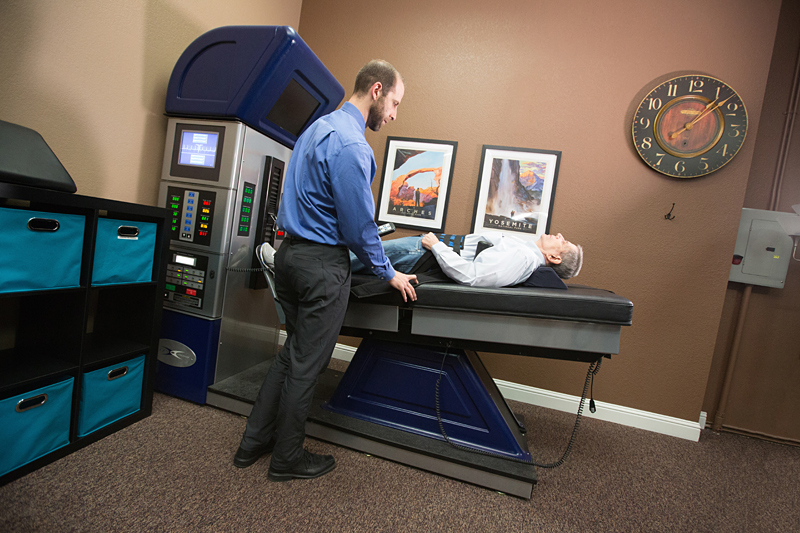Conditions
Disc Injuries are a Common Cause of Back Pain
Many patients come to Northern Nevada Chiropractic with bulging or herniated disc injuries. Disc injuries are so crucial to quality of life because your intervertebral discs are the shock absorbers of the spine. Think of them as a jelly donut, with a soft gelatinous inner center and a firmer exterior. When a disc fails, a number of injuries can happen such as bulges or herniations.
Causes of Disc Herniations and Bulges
The lumbar discs are vulnerable to much of the stress in the lumbar spine. Since they are at the bottom of the spine, they bear all the weight of the structures above. The Lumbar disc is made of Fibrocartilage, which means it is very tough material.
The forces which do the most damage to the lumbar discs are shear forces. Shear force causes one vertebra to slip on top of another vertebra below. Shear force injuries can come from a patient leaning forward and twisting their low back as when they are doing common activities such as:
- Starting a lawnmower
- Shoveling snow
- Bowling
- Loading a washing machine or dishwasher
- Picking up a duffle bag, newspaper or toy from the floor
Spinal stabilization muscles exist to keep the lower back upright and to keep the vertebra from slipping on top of one another. When these muscles become weak due to deconditioning, pregnancy, weight gain, sloth, incapacitating injury where muscles atrophy, or aging, the lumbar muscles weaken and place more strain on the ligaments and discs of the lower back.
The muscles are responsible for stabilizing the spine in your normal middle range of motion, while the ligaments stabilize your spine at end range. Imagine bending over to tie your shoes. You are able to completely relax the muscles in your back and the ligaments take over providing stability in your lower back. If those ligaments are too tight you will feel stiff and you will lack the flexibility to get down to tie your shoes.
The problem arises when a 40-year-old person wants to move like a teenager. The ligaments and discs are injured because the muscle tone is not as firm and the discs holding the spine together are injured due to poor posture, overuse, and degeneration.
The disc at the L4-5 segment is the largest structure in your body without a direct blood supply. When a disc is bulging out and causing pressure on a nearby spinal nerve the pains can be intense and run down the legs.
Signs and Symptoms of Disc Injuries
A disc bulge is when the disc becomes deformed due to physical stress, causing the sharp end of the disc to distend. Think of a rubber balloon when it is squeezed swelling away from the pressure.
A herniated disc refers to when the bulge perforates through the firm exterior of the disc, causing the disc to fail. The consistency of a herniation is very gummy (think molasses) so it will not leak completely empty.
A herniated disc or a bulging disc can irritate nearby nerves and result in pain, numbness or weakness in an arms or legs. On the other hand, many people experience no symptoms from a herniated disc. The good news is that most people who have a herniated disk don’t need surgery to correct the problem.
Symptoms of a Herniated Disc or Bulging Disc
Most herniated discs occur in your lower back (lumbar spine), although they can also occur in your neck (cervical spine). The most common signs and symptoms of a herniated disc are:
- Arm or leg pain. If your herniated disc is in your lower back, you’ll typically feel the most intense pain in your buttocks, thigh and calf. It may also involve part of the foot. If your herniated disc is in your neck, the pain will typically be most intense in the shoulder and arm. This pain may shoot into your arm or leg when you cough, sneeze or move your spine into certain positions.
- Numbness or tingling. People who have a herniated disc often experience numbness or tingling in the body part served by the affected nerves.
- Weakness. Muscles served by the affected nerves tend to weaken. This may cause you to stumble, or impair your ability to lift or hold items.
You also can have a herniated disc without knowing it — herniated discs sometimes show up on spinal images of people who have no symptoms of a disc problem.
When to See a Doctor for Disc Injuries
Seek medical attention if your neck or back pain travels down your arm or leg, or if it’s accompanied by numbness, tingling or weakness. The doctors at Northern Nevada Chiropractic employ non-surgical spinal decompression to and laser therapy treat disc injuries.

Dr. Welch discusses spinal decompression therapy for disc bulges with KOLO
Spinal decompression therapy is used for a number of different treatments, but most specifically for disc bulges. It is also a very effective treatment for patients with sciatica or lower back pain. It is a non surgical, non invasive therapy that is actually quite relaxing. Spinal decompression therapy gives significant relief to patients with lower back issues.

